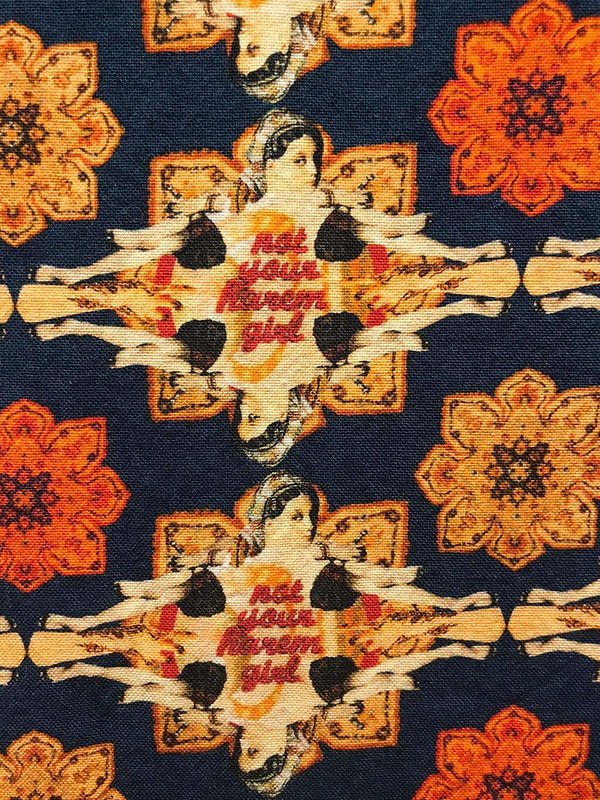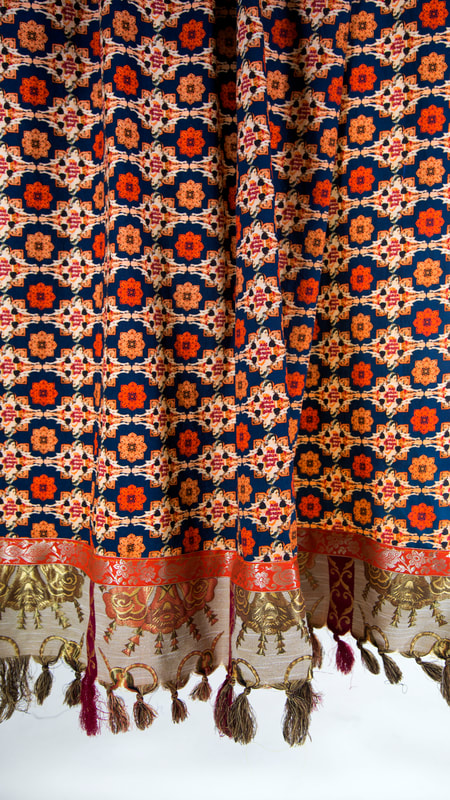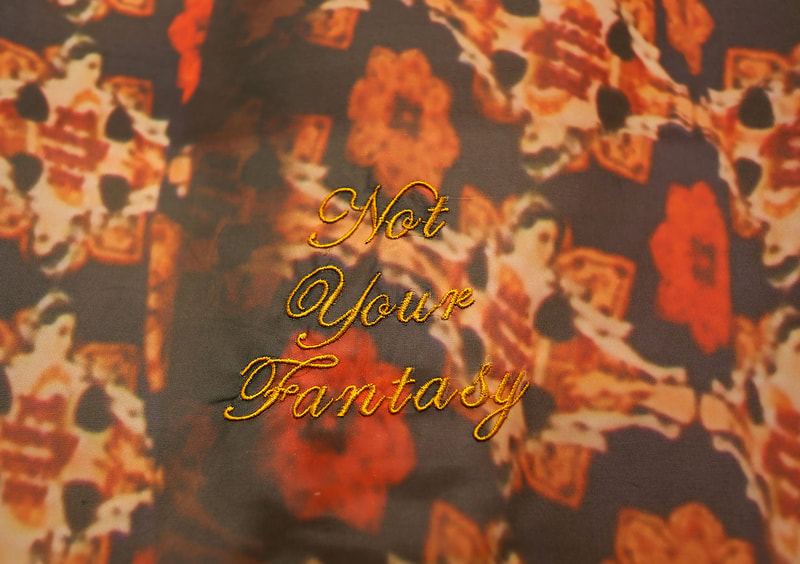Not Your Harem Girl
2018
Not Your Harem Girl has been designed using elements of Jean-Auguste-Dominique Ingres’ La Grande Odalisque, a well-known Orientalist artwork from the 19th Century. The pattern includes a scanned-in image of an embroidery Moledina created with the words ‘Not Your Harem Girl’ and also an image of a hand with a henna design she made from the same text; She often works in layers, taking time to create embroidery and henna that then feature in the work. When combined these elements form a pattern that resembles Islamic geometric art.
Islamic art is fundamentally based on the concept of Al-Tawhid (Divine Unity) (Burckhardt) and this is expressed through geometric symmetrical patterns that appear to be infinite. Designs intricately attempt to trace the origins in creation, encouraging viewers to reflect upon them not backwards but inwards (Critchlow, 1976). As such, Islamic art promotes reflection on the self and the universe and fosters an exploration of what lies beneath the visual surface.
Not Your Harem Girl interprets these concepts within a critique of Orientalist caricatures. Central to the success of the Orientalist movement was the appropriation of inherently Islamic iconography and the Muslim female form. As such, responding to and re-appropriating Orientalist art is an inherently de-colonial practice - gazing inwards brings these Islamic roots to the forefront, forcing the viewer to reckon with the distortion of these motifs, and how they heralded a deliberate erasure of Muslim female agency. Not Your Harem Girl is composed of a symmetrical geometric repeat pattern. The pattern is made from a myriad of elements which are not immediately perceptible. The work needs to be studied and contemplated to perceive its hidden depth, inviting the viewer to identify the different layers within the pattern and reflect on 19th Century Orientalism and it's prevalence in current society. The process of creating a pattern is a form of meditation and reflection, always returning to the concept of Tawhid through the reclamation of Islamic design principles that were the original influence for the Orientalists. The title is inspired by the poetry of Suheir Hammad.
Not your Fantasy, 2018, Farwa Moledina, Digital print on textile
2018
Not Your Harem Girl has been designed using elements of Jean-Auguste-Dominique Ingres’ La Grande Odalisque, a well-known Orientalist artwork from the 19th Century. The pattern includes a scanned-in image of an embroidery Moledina created with the words ‘Not Your Harem Girl’ and also an image of a hand with a henna design she made from the same text; She often works in layers, taking time to create embroidery and henna that then feature in the work. When combined these elements form a pattern that resembles Islamic geometric art.
Islamic art is fundamentally based on the concept of Al-Tawhid (Divine Unity) (Burckhardt) and this is expressed through geometric symmetrical patterns that appear to be infinite. Designs intricately attempt to trace the origins in creation, encouraging viewers to reflect upon them not backwards but inwards (Critchlow, 1976). As such, Islamic art promotes reflection on the self and the universe and fosters an exploration of what lies beneath the visual surface.
Not Your Harem Girl interprets these concepts within a critique of Orientalist caricatures. Central to the success of the Orientalist movement was the appropriation of inherently Islamic iconography and the Muslim female form. As such, responding to and re-appropriating Orientalist art is an inherently de-colonial practice - gazing inwards brings these Islamic roots to the forefront, forcing the viewer to reckon with the distortion of these motifs, and how they heralded a deliberate erasure of Muslim female agency. Not Your Harem Girl is composed of a symmetrical geometric repeat pattern. The pattern is made from a myriad of elements which are not immediately perceptible. The work needs to be studied and contemplated to perceive its hidden depth, inviting the viewer to identify the different layers within the pattern and reflect on 19th Century Orientalism and it's prevalence in current society. The process of creating a pattern is a form of meditation and reflection, always returning to the concept of Tawhid through the reclamation of Islamic design principles that were the original influence for the Orientalists. The title is inspired by the poetry of Suheir Hammad.
Not your Fantasy, 2018, Farwa Moledina, Digital print on textile



